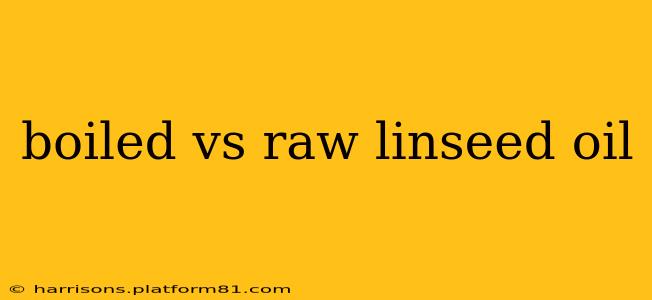Linseed oil, derived from flax seeds, is a popular drying oil used in various applications, from wood finishing to paint making. However, there's a crucial distinction between boiled and raw linseed oil, each offering unique properties and best suited for specific tasks. Understanding these differences is key to choosing the right oil for your project.
What is Raw Linseed Oil?
Raw linseed oil is exactly what it sounds like – linseed oil in its purest, unprocessed form. It's extracted from flax seeds and undergoes minimal refinement, retaining its natural color and composition. This means it contains all the natural components of the flaxseed, including some potentially harmful impurities, and it dries much more slowly.
Pros of Raw Linseed Oil:
- Penetration: Its slow drying time allows for deeper penetration into wood, creating a more durable and protective finish over time. This makes it ideal for wood preservation and enhancing the natural beauty of the grain.
- Natural: It's a completely natural product, appealing to those seeking environmentally friendly options.
- Food Safe (With Caution): While not recommended for direct food contact, some food-grade raw linseed oil exists, which is specifically processed for safety. However, even food-grade oil should always be thoroughly cured before any potential contact with food.
Cons of Raw Linseed Oil:
- Slow Drying Time: The slow drying time is a significant drawback for many projects. It can take days or even weeks to cure completely.
- Susceptibility to Oxidation: Its slower drying makes it susceptible to oxidation and rancidity if not properly stored and used.
- Potential for Spoilage: Impurities present in raw linseed oil can promote spoilage if not properly handled and stored.
What is Boiled Linseed Oil?
Boiled linseed oil isn't actually boiled. The name is a historical artifact. Modern "boiled" linseed oil is raw linseed oil that has been treated with metallic driers (like cobalt, manganese, or lead). These driers accelerate the oxidation and polymerization process, significantly reducing the drying time.
Pros of Boiled Linseed Oil:
- Fast Drying Time: This is the main advantage. It dries considerably faster than raw linseed oil, often within a day or two, depending on conditions.
- Easier to Use: The faster drying time makes it much more convenient for many applications.
- Improved Durability (Often): The faster drying can sometimes result in a more durable finish, depending on the application and the quality of the oil.
Cons of Boiled Linseed Oil:
- Less Penetration: The faster drying time means it may not penetrate wood as deeply as raw linseed oil.
- Contains Additives: The presence of metallic driers is a drawback for those seeking a completely natural product. Some people are also sensitive to these additives.
- Can Yellow Over Time: The added driers can sometimes contribute to yellowing of the finished surface over time.
Which Linseed Oil Should I Use?
The choice between boiled and raw linseed oil depends entirely on the project:
-
Raw linseed oil: Best for applications where deep penetration and a long-lasting, natural finish are prioritized. This includes wood preservation, fine furniture finishing where a slow cure is acceptable, and treating exterior wood.
-
Boiled linseed oil: Best for projects where a faster drying time is crucial. This includes painting (as a medium or component), finishing less valuable wooden items, and sealing wood quickly before further finishing steps.
What are the Safety Precautions for Using Linseed Oil?
Both raw and boiled linseed oil pose fire hazards when used in large quantities or applied thickly. Always ensure adequate ventilation and keep away from open flames during application and curing. Linseed oil rags should be disposed of properly, as they can spontaneously combust if not allowed to dry completely.
How Long Does Linseed Oil Take to Dry?
The drying time for linseed oil varies significantly based on the type of oil, environmental conditions (temperature and humidity), and thickness of application. Raw linseed oil takes considerably longer to dry (days or even weeks) than boiled linseed oil (hours to days).
Is Boiled Linseed Oil Toxic?
While not inherently toxic, boiled linseed oil contains metallic driers which can be irritating to the skin or respiratory system for some individuals. Always use appropriate ventilation and wear gloves during application. Lead-based driers are less common now due to health concerns, but you should check the product's label to confirm the driers used.
Can You Use Boiled Linseed Oil for Food-Safe Surfaces?
No, boiled linseed oil is not suitable for food-safe surfaces due to the presence of metallic driers. These additives are not food-grade and can leach into food, potentially causing health problems.
By understanding the distinctions between boiled and raw linseed oil, you can make an informed decision to achieve the best results for your project while ensuring safety. Remember to always read and follow the manufacturer's instructions for safe handling and application.
